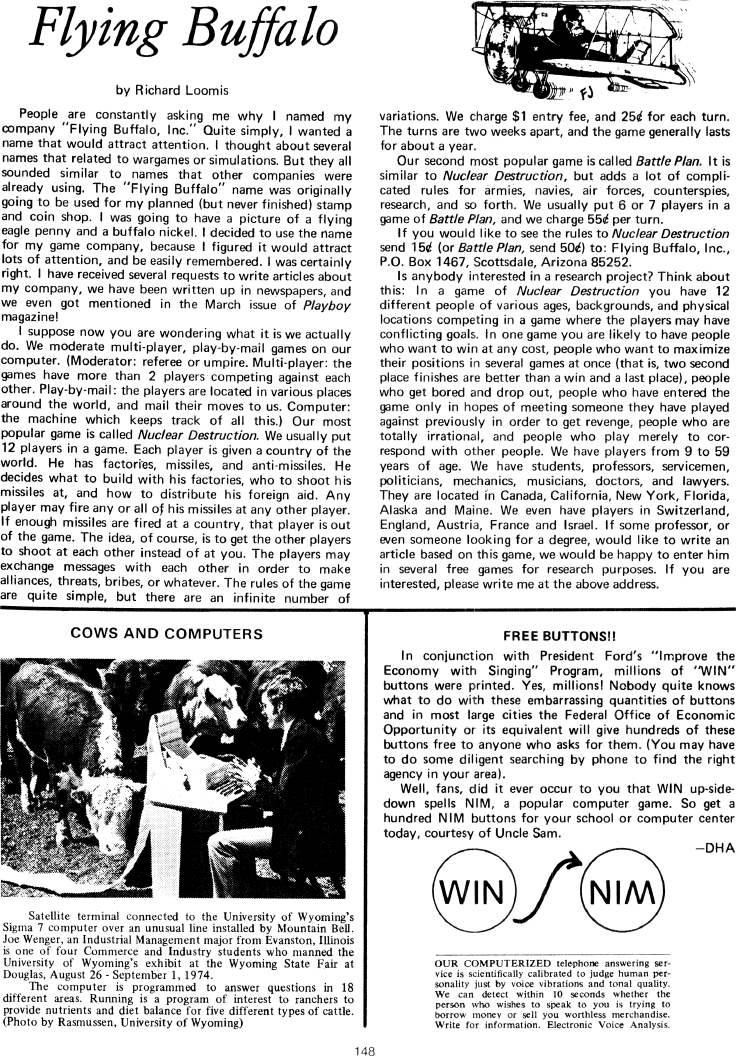The Best of Creative Computing Volume 1 (published 1976)
Flying Buffalo (Play-by-mail game company)

Flying Buffalo
by Richard Loomis
People are constantly asking me why I named my
company "Flying Buffalo, Inc." Ouite simply, I wanted a
name that would attract attention. I thought about several
names that related to wargames or simulations. But they all
sounded similar to names that other companies were
already using. The "Flying Buffalo" name was originally
going to be used for my planned (but never finished) stamp
and coin shop. I was going to have a picture of a flying
eagle penny and a buffalo nickel. I decided to use the name
for my game company, because I figured it would attract
lots of attention, and be easily remembered. I was certainly
right. I have received several requests to write articles about
my company, we have been written up in newspapers, and
we even got mentioned in the March issue of Playboy
magazine!
I suppose now you are wondering what it is we actually
do. We moderate multi-player, play-by-mail games on our
computer. (Moderator: referee or umpire. MuIti~player: the
games have more than 2 players competing against each
other. Play-by-mail: the players are located in various places
around the world, and mail their moves to us. Computer:
the machine which keeps track of all this.) Our most
popular game is called Nuclear Destruction. We usually put
12 Plavers in a game. Each player is given a country of the
world. He has factories, missiles, and anti-missiles. He
decides what to build with his factories, who to shoot his
missiles at, and how to distribute his foreign aid. Any
player may fire any or all of his missiles at any other player.
If enougt missiles are fired at a country, that player is out
of the game. The idea, of course, is to get the other players
to shoot at each other instead of at you. The players may
exchange messages with each other in order to make
alliances, threats, bribes, or whatever. The rules of the game
are quite simple, but there are an infinite number of
[image]
variations. We charge $1 entry fee, and 25¢ for each turn.
The turns are two weeks apart, and the game generally lasts
for about a year.
Our second most popular game is called Battle Plan. It is
similar to Nuclear Destruction, but adds a lot of complicated rules for armies,
navies, air forces, counterspies, research, and so forth. We usually put 6 or 7
players in a
game of Battle Plan, and we charge 55d per turn.
If you would like to see the rules to Nuclear Destruction
send 15¢ (or Battle Plan, send 50é) to: Flying Buffalo, Inc.,
P.0. Box 1467, Scottsdale, Arizona 85252.
Is anybody interested in a research proiect? Think about
this: ln a game of Nuclear Destruction you have 12
different people of various ages, backgrounds, and physical
locations competing in a game where the players may have
conflicting goals. In one game you are likely to have people
who want to win at any cost, people who want to maximize
their positions in several games at once (that is, two second
place finishes are better than a win and a last place), people
who get bored and drop out, people who have entered the
game only in hopes of meeting someone they have played
against previously in order to get revenge, people who are
totally irrational, and people who play merely to correspond with other people.
We have players from 9 to 59
years of age. We have students, professors, servicemen,
politicians, mechanics, musicians, doctors, and lawyers.
They are located in Canada, California, New York, Florida,
Alaska and Maine. We even have players in Switzerland,
England, Austria, France and Israel. If some professor, or
even someone looking for a degree, would like to write an
article based on this game, we would be happy to enter him
in several free games for research purposes. If you are
interested, please write me at the above address.
COWS AND COMPUTERS
Satellite terminal connected to the University of Wyoming's
Sigma 7 computer over an unusual line installed by Mountain Bell.
Joe Wenger. an Industrial Management major from Evanston, Illinois
is one of four Commerce and Industry students who manned the
University of Wyoming's exhibit at the Wyoming State Fair at
Douglas, August 26 - September 1, 1974.
The computer is programmed to answer questions in 18
different areas. Running is a program of interest to ranchers to
provide nutrients and diet balance for five different types of cattle.
(Photo by Rasmussen, University of Wyoming)
FREE BUTTONS!!
In conjunction with President Ford's "Improve the
Economy with Singing" Program, millions of "WIN"
buttons were printed. Yes, millions! Nobody quite knows
what to do with these embarrassing quantities of buttons
and in most large cities the Federal Office of Economic
Opportunity or its equivalent will give hundreds of these
buttons free to anyone who asks for them. (You may have
to do some diligent searching by phone to find the right
agency in your area).
Well, fans, did it ever occur to you that WIN up-side-down spells NIM, a popular
computer game. So get a
hundred NIM buttons for your school or computer center
today, courtesy of Uncle Sam.
-DHA
[image]
OUR COMPUTERIZED telephone answering service is scientifically calibrated to
judge human personality just by voice vibrations and tonal quality.
We can detect within I0 seconds whether the
person who wishes to speak to you is trying to
borrow money or sell you worthless merchandise.
Write for information. Electronic Voice Analysis.


